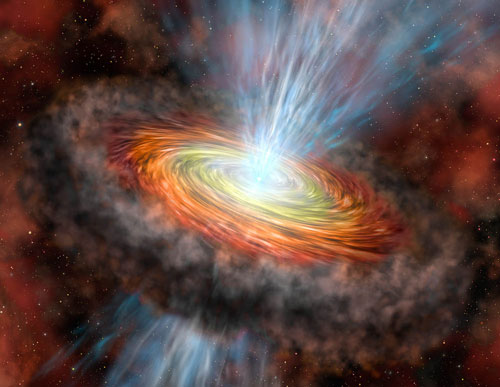A Massive Star is Born: RIT astronomer peers into stellar nursery
Gemini Observatory, artwork by Lynette Cook
Caption: Artist’s conception of W33A showing the accretion disk (yellow/orange), torus (dark ring around disk) and bi-polar outflow jets (blue) within the dense clouds of its stellar nursery.
Explaining how the most massive stars are born, deep within their stellar nurseries, is one of the most persistent mysteries in modern astronomy. Observations at the Gemini Observatory provide convincing new evidence that these stellar heavyweights may be born in much the same manner as lightweights like the sun.
“The problem is that when the most massive stars form it happens very quickly compared to stars like our sun, and by the time they break free of their natal clouds they are already the finished article,” says Ben Davies, assistant research scientist at Rochester Institute of Technology’s Rochester Imaging Detector Laboratory, and formerly of the University of Leeds in the United Kingdom. “If you want to see a massive star in the process of forming, you need to be able to see through the obscuring clouds to where the action is.”
Davies led an international team of researchers who brought infrared sensitivity and the extreme resolution of adaptive optics to bear on the problem. This allowed the team to penetrate the obscuring gas and dust clouds surrounding the massive proto-star W33A.
Davies’ team calculates that the prenatal star is at least 10 times more massive than our sun, and is still rapidly growing. According to Davies, this is the first time scientists have been able to unravel the dynamics deep inside a heavyweight stellar nursery at this level of detail. “We’ve caught a massive star in the act of formation and find signatures of an accretion disk embedded within a torus of gas and dust,” Davies says. “We also see material being blasted away from the poles at speeds of up to 300 kilometers per second. These features are all common to formation process of much smaller stars.”
The massive star forming inside of W33A is completely obscured in optical light (as seen by the human eye) but, as Davies explains, “while the optical light is attenuated by about a factor of 10,000, much of the infrared light can pass through the intervening material. This affords us a glimpse of what is happening deep inside W33A’s natal cloud.”
Several conflicting theories strive to explain how massive stars are born, whether it is a scaled-up version of low-mass star formation, or whether a completely different physical process is involved. Observations with adaptive optics and infrared spectroscopy are catching massive stars as they form.
Davies’ team used the power of adaptive optics to remove atmospheric blurring and then dissected the light using the Near-Infrared Integral Field Spectrograph on the Frederick C. Gillett Gemini North telescope on Hawaii’s Mauna Kea. It creates what is sometimes called a spectral image consisting of about 2,000 individual spectra in a square array covering the heart of W33A. These data are assembled into a “data cube” which allow the scientists to look at individual features of the spectra at each point and assemble a multi-dimensional image of the environment around the birthing star.
“We were not only able to resolve the inner nebula on small spatial scales but also probe its dynamics by measuring the Doppler-shift of light from the glowing gas to determine its velocity and how it flows around the forming star,” says Davies. “This is an amazingly powerful tool for understanding the inner workings of how stars actually form.”
Known as a Massive Young Stellar Object, W33A is located about 12,000 light years away, toward the constellation of Sagittarius. Previous studies of this object only hinted at its dynamic nature but, until now, no stellar objects have been studied at this level of detail using the combination of adaptive optics and integral field spectroscopy used by the Davies team.
Colin Aspin of the Institute for Astronomy at the University of Hawai’i adds, “This result provides us with one of the first clues that high-mass stars form in similar ways to their low-mass counterparts and shows the power of integral-field near-infrared spectroscopy as a way of probing the youngest phases of stellar evolution.”
The team’s accepted paper is pending publication in the Monthly Notices of the Royal Astronomical Society.
Note: Rochester Institute of Technology is internationally recognized for academic leadership in computing, engineering, imaging technology, and fine and applied arts, in addition to unparalleled support services for students with hearing loss. Nearly 17,000 full- and part-time students are enrolled in more than 200 career-oriented and professional programs at RIT, and its cooperative education program is one of the oldest and largest in the nation.
For two decades, U.S. News & World Report has ranked RIT among the nation’s leading comprehensive universities. RIT is featured in The Princeton Review’s 2010 edition of The Best 371 Colleges and in Barron’s Best Buys in Education. The Chronicle of Higher Education recognizes RIT as a “Great College to Work For.”
The Gemini Observatory is an international collaboration with two identical 8-meter telescopes. The Frederick C. Gillett Gemini Telescope is located at Mauna Kea, Hawai’i (Gemini North) and the other telescope at Cerro Pachón in central Chile (Gemini South), and hence provide full coverage of both hemispheres of the sky. Both telescopes incorporate new technologies that allow large, relatively thin mirrors under active control to collect and focus both optical and infrared radiation from space.
The Gemini Observatory provides the astronomical communities in each partner country with state-of-the-art astronomical facilities that allocate observing time in proportion to each country's contribution. In addition to financial support, each country also contributes significant scientific and technical resources. The national research agencies that form the Gemini partnership include: the U.S. National Science Foundation, the U.K. Science and Technology Facilities Council, the Canadian National Research Council, the Chilean Comisión Nacional de Investigación Cientifica y Tecnológica, the Australian Research Council, the Argentinean Consejo Nacional de Investigaciones Científicas y Técnicas and the Brazilian Conselho Nacional de Desenvolvimento Científico e Tecnológico.
The University of Leeds is one of the largest higher education institutions in the United Kingdom and a member of the Russell Group of research-intensive universities.















